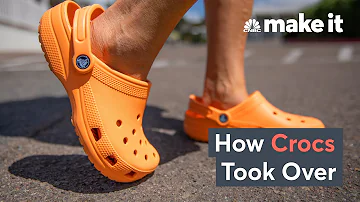From Mocked to Market Leader: What Crocs Teaches Us About Branding
Few brands have captured the cultural zeitgeist—and controversy—like Crocs. Once dismissed as an ugly fad, Crocs engineered an incredible turnaround, evolving into a billion-dollar powerhouse and a symbol of self-expression. What can entrepreneurs, startups, and marketers learn from this unlikely brand resurrection? In this deep dive, we’ll examine actionable strategies for building a resilient and engaging brand, using the Crocs transformation as our blueprint. Whether you’re launching a new product or reinventing your company, these insights can set your brand on the path to enduring success.
1. Start with a Unique Selling Proposition (USP)
Crocs’ Comfort Roots
- Early Days: Crocs originated from a simple need: comfortable, slip-resistant shoes for boating. Their innovative foam resin technology, initially dismissed for being “ugly,” set them apart.
- Clear USP: Their unapologetic focus on function—comfort, durability, and practicality—turned Crocs into a must-have for healthcare, hospitality, and families.
Takeaway: A strong USP, even if polarizing, attracts dedicated fans and creates word-of-mouth buzz. Don’t dilute what makes your product unique.
Action Steps:
- Define your brand’s core benefit. Is it innovation, affordability, style, or reliability?
- Identify target audiences whose values align with your USP.
- Craft messaging that boldly reinforces your differentiator—be memorable, even if controversial.
2. Embrace Feedback and Adapt to Strengthen Your Branding
Navigating the Backlash and Refocusing
- Early Criticism: Crocs were fiercely polarizing. Viral memes and fashion critics mocked them—yet passionate users swore by their comfort.
- Crisis & Recovery: After overextending product lines and markets, Crocs faced a $185M loss in 2008. The turnaround began by:
- Pruning 80% of SKUs, focusing back on the classic clog design.
- Streamlining distribution and closing underperforming stores.
Lesson Learned: Feedback—positive or negative—can reveal what really matters to customers. Lean into your strengths, and don’t try to be everything to everyone.
How to Apply:
- Conduct regular audience surveys and reviews.
- Identify bestsellers and double down on products/services your fans love.
- Listen to critics: what you can’t fix (e.g., Crocs’ style), you can reframe as a badge of authenticity.
3. Leverage Strategic Partnerships for Effective Branding
Elevating from Utility to Pop Culture Icon
- Celebrity Collaborations: Crocs’ partnerships with icons like Justin Bieber and Post Malone turned head-scratching footwear into coveted streetwear.
- “Drop” Culture: Limited edition releases, some reselling for $1,000+, spawned hypebeast excitement and a sense of exclusivity.
- Social Proof: By associating with trendsetters and celebrities, Crocs rebranded from unfashionable to must-have.
How You Can Do It:
- Identify influencers or niche thought leaders who share your brand values.
- Co-create limited products or content to generate buzz.
- Use social proof (testimonials, user-generated content) to validate your brand’s desirability.
4. Foster Community and Personalization in Your Branding
Cultivating Loyalty & Ownership
- Brand Community: Crocs turned buyers into passionate fans and collectors. Online forums and social media groups fueled organic growth.
- Customization: ‘Jibbitz’ charms gave customers a way to express their identities, significantly boosting brand affinity, especially with Gen Z.
Takeaway: Personalization isn’t just a product feature—it’s a way for customers to own your brand story.
Action Steps:
- Create spaces for your customers to interact (forums, Facebook groups).
- Offer customization options or encourage sharing of personalized experiences.
- Feature user stories, testimonials, and social posts to deepen loyalty.
5. Resilience and Sustaining Long-Term Vision
Weathering the Storm—Twice
- Overcoming Crises: Hit by the global recession, Crocs nearly collapsed, only to engineer a comeback by focusing on its core. Years later, COVID-19 threatened retail again, but Crocs’ lean strategy and cash reserve gave it room to adapt.
- Evolution Over Perfection: Crocs championed ‘ugly fashion’ and ‘athleisure’, riding changes in consumer preferences rather than chasing every trend.
Your Playbook:
- Build cash reserves and safeguard your core business.
- Use market downturns to reevaluate, not just cut costs.
- Stay alert to emerging trends—be ready to innovate, but never at the expense of your brand DNA.
Key Takeaways: Crocs’ Blueprint for Building an Iconic Brand
- Clarify your unique selling proposition and stick to your strengths—even if it means being polarizing.
- Listen to feedback and adapt, but don’t lose your identity chasing every new market.
- Leverage the power of partnerships with influencers/celebrities to radically reposition your brand.
- Cultivate a passionate community through personalization and user engagement.
- Prioritize resilience and keep a long-term vision to weather inevitable challenges.
“Be bold, be resilient, and let your customers own a piece of your story—that’s the journey from ridicule to icon.”
Ready to Build Your Own Brand?
Apply these Crocs-inspired lessons to your own journey. What’s your brand’s biggest differentiation? How can you harness community and authenticity?
Share your thoughts in the comments, and subscribe for more deep dives on building iconic brands!
[IMAGE ALT: A detailed description of branding strategies used by Crocs, showcasing their unique selling propositions and community engagement techniques.]





